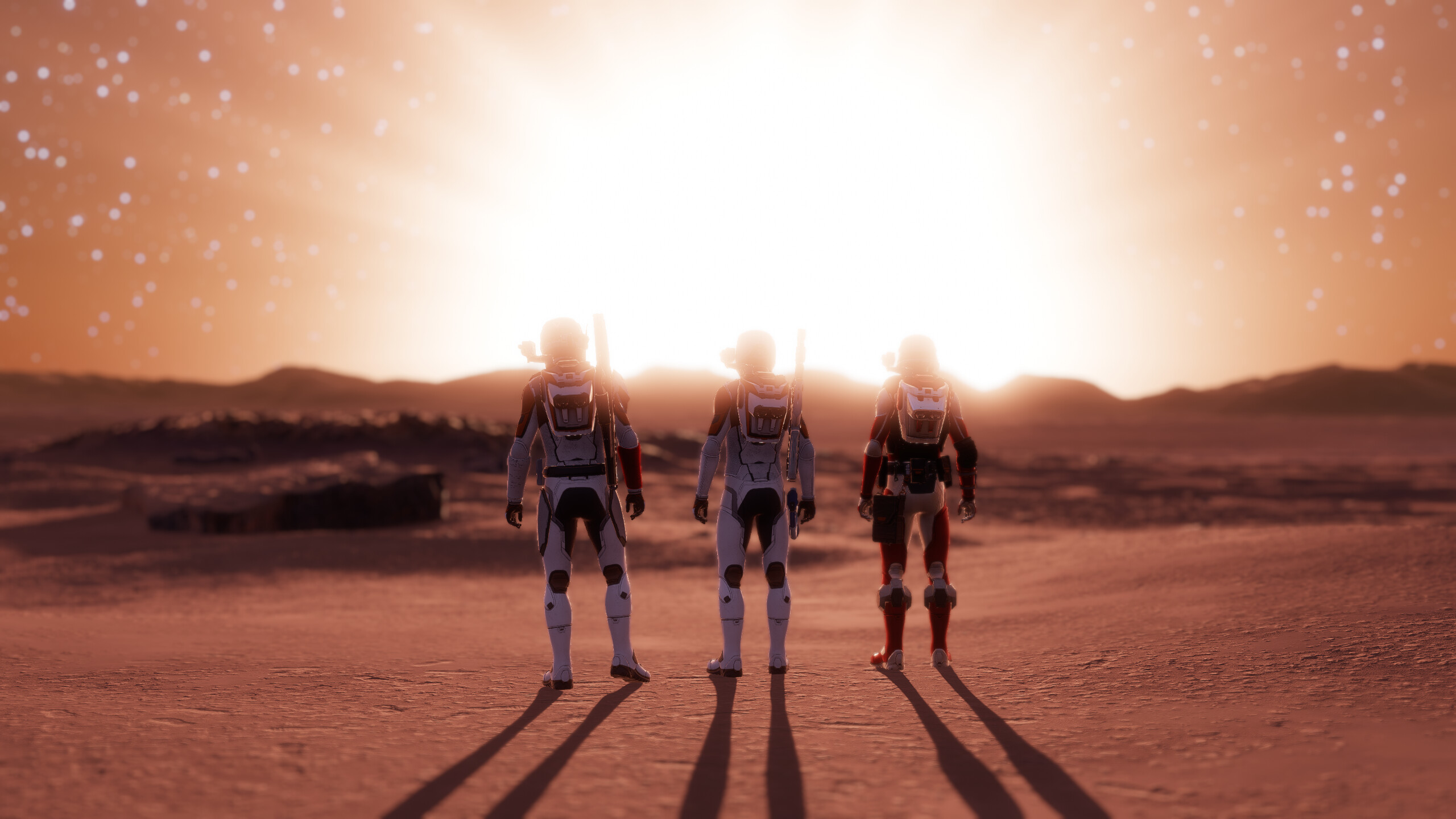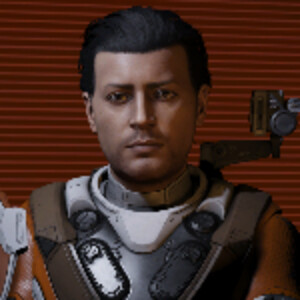Paresa News Network Interviews The Nova Science Team
24 Oct 2024ASmallerMolecule
The Nova Navy has earned the silver medal in exploration.(By ASmallerMolecule, mMONTAGEe, Hellrider, Varaxia)
---------------------------------------------------------------------------------------------------------

On the twelfth of September, a particular portion of the Nova Navy, the Nova Science Team, began an initiative known as the Order of Heavens Charting Project. Praetor Hellrider led the initiative, calling for explorers in the Nova Navy to help him map the Eoch Pruae sector, specifically the "Order of Heavens" tourist site discovered by Kentarch Peritus Harrison Wells years prior. This binary pair of Earth-like worlds would end up being the capital of this area, and later on, Commanders Mathew Holins and William Lunaris joined the effort. Exploration of the area throttled afterward, leading to many intriguing finds.
We interviewed the prominent members of the Nova Science Team: Commanders Harrison Wells, William Lunaris, Mathew Holins, and Hellrider. Firstly, we asked Mr. Wells, addressing from Kroehl Orbital in Udegoci, how the charting project began.
"It began when Hellrider was knocking on my doors all the way from Paresa. I was already in the Order of Heavens charting it alone, but then he proposed the project to me - and I remember his exact words: "We should do it at your tourist beacon. In your Bubble." When we eventually did get the project kicking, me and Hellrider contacted Mathew while he was at the galaxy's ceiling in a Diamondback Explorer. He had a knack for photography, so this was an obvious request. We were joyous when he told us he'd be willing to join. I prepared my carrier and set out, Hellrider following with his soon after. Some days after we arrived at the Order of Heavens, Mathew settled down on my fleet carrier Destiny."
The ultimate goal of this expedition was to earn the fabled gold medal by getting first place in the exploration leaderboards. However, since day one of the season a squadron known as Endurance Exploration had ascended to the top very quickly; they had been hoarding multiple billions worth of cartography data. So too was Nova Navy, having a headstart of 8 billion credits. Our numbers rose slowly to 14 billion points, but Endurance would succeed in the end, having an incredible 33 billion points. Asking Mr. Wells how he felt about the loss, he provided this answer:
"Despite our wishes for the golden medal not coming true, I'd be lying if I said we returned empty-handed. A silver medal is seriously nothing to sneeze at. It serves as a reminder of charting the Nova Bubble and uncovering the marvels it held, yet still, there was more to find. We secured our names among extremely rare silicate vapor atmosphere worlds; only 226 have been discovered in the entire galaxy. We found 2 of those worlds along the trip. Perhaps it's not the silver medal that truly matters, it's the camaraderie and bonds we have. There is nothing like exploring with your friends, having fun in the void, chatting around water geysers... and sharing the sights."
Commander William Lunaris, addressing from his home on Paresa 3, was also asked how he became involved in the project.
"I heard of the expedition only a couple of weeks after the carriers had reached their destination. Having been resting in my lonely homestead for a couple of years, I got to dust off my trusty Diamondback Explorer and take her out into the void again. The journey to the Order of Heavens was as arduous as it was tedious, a loop of jumping and refueling, jumping and refueling, jumping and refueling... If you were to ask me why I did it in an unengineered ship, I'd tell you I have no idea."
This section will now elaborate on what the Commanders felt and saw during the expedition. Mr. Holins was first, and when he was asked about what worlds the Nova Science Team found, he responded with this:
"The charting project made me realize how many gems are under any explorer's nose. All we did was set our routes to economical mode so we'd jump to the most systems. I remember a discovery of Harrison's where there was an awesome pair of binary worlds near a brown dwarf. It's a highlight of our trip. The planets' proximity to the brown dwarf allowed for a very bright light in the sky. I also discovered multiple moons that were close to their gas giant's rings, one of them being so close I could see the asteroids orbit the planet. Hot Jupiters, close binary moons, oxygen atmosphere ice planets, and believe it or not: 4 water worlds orbiting a gas giant... too many vistas to count. And now that Zorgon Peterson's new Mandalay has arrived in the shipyards, returning to explore is something to consider."

Mr. Lunaris provided his thoughts as well:
"Gotta admit, I didn't expect that expedition to be nearly as grand. What we discovered out there was nothing short of spectacular. We discovered numerous habitable worlds, each supporting ecosystems never before observed. Craters that were hundreds of kilometers across, moons that were enveloped by atmospheres of water—that does not even begin to describe the number of wonders that we uncovered in our little sector of space. I'm eager to return to the void in my recently purchased Mandalay and chart the stars that dot our boundless galaxy yet again."
Praetor Hellrider, addressing from his fleet carrier, was next.
"In the last 2 months we discovered systems worth close to 30 billion credits. Out of this, 12,000 planets were candidates for terraformation. Imagine planets so rare, that humanity has only seen 226 of them. We found 2. Imagine Paresa 3. We found more than 100 Paresa 3s. Even better, we found them in the most crazy configurations: moons of gas giants, or with rings, even around giant stars. This is a catalog of the Milky Way's miracles, which can be used by any explorer deciding where to go. These are just a few examples of what explorers could find. We proved that united, we can chart as big a portion comparable to the largest exploration squadrons. When we look at the exploration effort since Universal Cartographics had an idea about rewarding squadrons, humanity discovered only massive chunks of the galaxy twice. The first time was when the ranking system was completely new; another was when Distant Worlds 2 was done and dusted. Distant Worlds 2 was the biggest expedition humanity had ever done, with a fleet counting 1000s of ships. When it was complete, humanity constructed a station just a few light years away from Sagittarius A*. Such a deed required them to discover more than we did these past few months. We made history. Because without us, and 2 other groups, those few months would've been the worst in history."
And lastly, before concluding this article, Mr. Wells provided a statement congratulating the Commanders who engaged in the Order of Heavens Charting Project.
"I want to thank every Commander for helping us win the silver medal and sharing their discoveries. A big thanks to the Nova Navy pilots who joined us on the Order of Heavens Charting Project, participating in our competition for the silver medal with Endurance Exploration. The Commanders Hellrider, Matthew Hollins, William Lunaris, LernanRuss, Krymbo, Walker, Jeremaya, and OctavianScroodge all played a part, and without their help and our collective work and contributions, big or small, is something to applaud for."
Paresa News Network thanks the Nova Science Team for participating in this interview.
